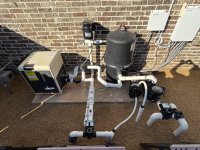In this recent thread, I asked about some issues I was having with my Hayward heater. I ended up replacing my Hayward 500btu heater with a Pentair Mastertemp 400btu heater. I also had the installer plumb in a manual heater bypass. My updated equipment pad can be seen in the photo below. I will also post a photo of the old installation for comparison.
On the positive side, this new heater appears, to me at least, to heat water just as quickly or possibly more quickly than my Hayward, which is surprising given that it is 100btu less. But so far I have no complaints about its performance in that regard.
But one thing I've noticed since the install is that head loss with the new system seems to be greater than with my Hayward. The main reason I notice this is because I have to run the pump at higher speeds in order to achieve the same water flow. The way I am judging water flow is by effects on the pool such as bubbles produces by the spa jets or amount of water that goes over the spillover.
Because of this, I've had to step up my pump speeds for two main reasons: 1) in pool mode, water continuously runs through the spillover and if there is not enough volume going through the spa it doesn't really spillover just kind of runs down the side of the spa, which I imagine is not great for the rock over time, and 2) in spa mode just to get enough jet action to make a good spa experience.
Even given the above, I have set my system to never run the pump at more than 90%. In pool mode, I can run between 55-65% to get enough volume for spillover (I used to be able to go as low as 45%), and in spa mode, I usually run 80-90% to get make the spa experience acceptable (I used to go as low as 75%). So, the differences aren't huge. But In pool mode, I can no longer use my system's "low speed" because my automation system maxes out low speed setting at 50% and that won't generate enough flow for the spillover. So, I am just using the "high speed" setting exclusively in pool mode and finding the lowest speed that works.
This all seems ok to me. I just wanted to check here to see if anyone has any thoughts on the above or anything I'm missing or not thinking about that might work better.


On the positive side, this new heater appears, to me at least, to heat water just as quickly or possibly more quickly than my Hayward, which is surprising given that it is 100btu less. But so far I have no complaints about its performance in that regard.
But one thing I've noticed since the install is that head loss with the new system seems to be greater than with my Hayward. The main reason I notice this is because I have to run the pump at higher speeds in order to achieve the same water flow. The way I am judging water flow is by effects on the pool such as bubbles produces by the spa jets or amount of water that goes over the spillover.
Because of this, I've had to step up my pump speeds for two main reasons: 1) in pool mode, water continuously runs through the spillover and if there is not enough volume going through the spa it doesn't really spillover just kind of runs down the side of the spa, which I imagine is not great for the rock over time, and 2) in spa mode just to get enough jet action to make a good spa experience.
Even given the above, I have set my system to never run the pump at more than 90%. In pool mode, I can run between 55-65% to get enough volume for spillover (I used to be able to go as low as 45%), and in spa mode, I usually run 80-90% to get make the spa experience acceptable (I used to go as low as 75%). So, the differences aren't huge. But In pool mode, I can no longer use my system's "low speed" because my automation system maxes out low speed setting at 50% and that won't generate enough flow for the spillover. So, I am just using the "high speed" setting exclusively in pool mode and finding the lowest speed that works.
This all seems ok to me. I just wanted to check here to see if anyone has any thoughts on the above or anything I'm missing or not thinking about that might work better.



